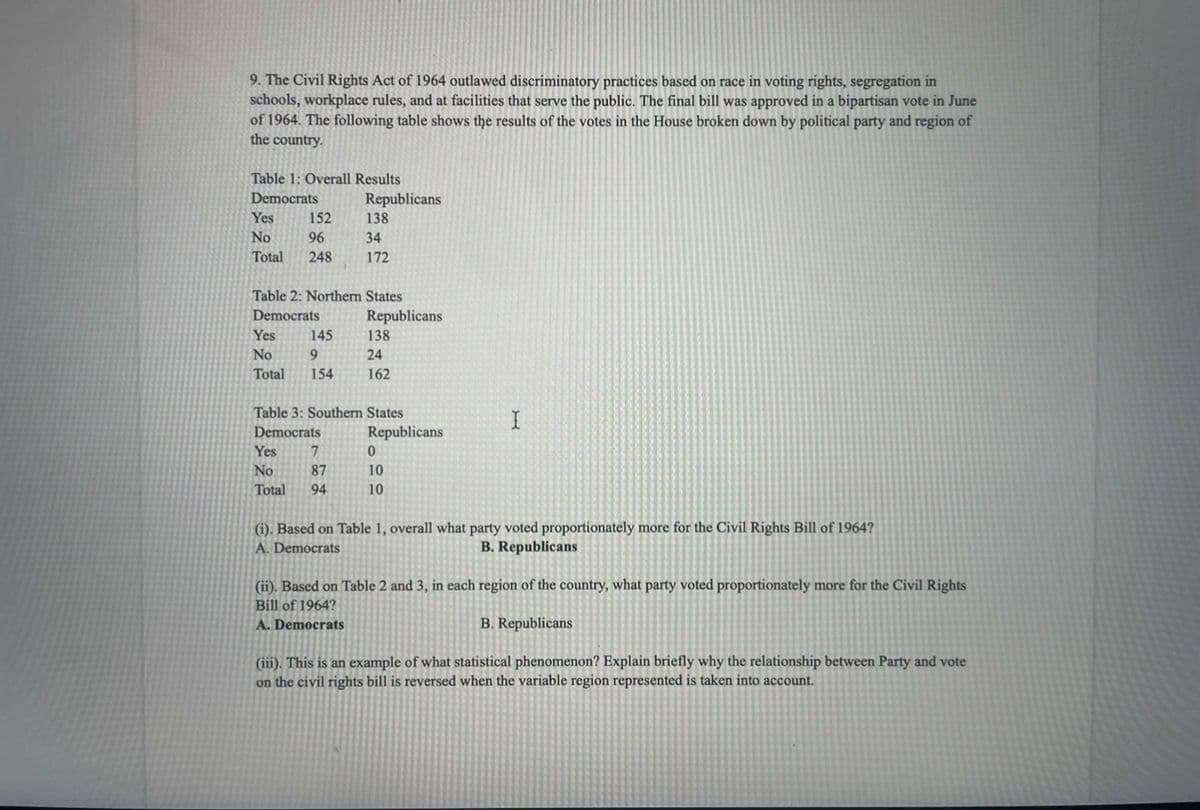9. The Civil Rights Act of 1964 outlawed discriminatory practices based on race in voting rights, segregation in schools, workplace rules, and at facilities that serve the public. The final bill was approved in a bipartisan vote in June of 1964. The following table shows the results of the votes in the House broken down by political party and region of the country. Table 1: Overall Results Democrats Republicans 138 Yes 152 No 96 34 Total 248 172 Table 2: Northem States Democrats Republicans Yes 145 138 No 6. 24 Total 154 162 Table 3: Southern States I Democrats Republicans Yes 7. No 87 10 Total 94 10 (1). Based on Table 1, overall what party voted proportionately more for the Civil Rights Bill of 1964? A. Democrats B. Republicans (ii). Based on Table 2 and 3, in each region of the country, what party voted proportionately more for the Civil Rights Bill of 1964? A. Democrats B. Republicans (ii). This is an example of what statistical phenomenon? Explain briefly why the relationship between Party and vote on the civil rights bill is reversed when the variable region represented is taken into account.
9. The Civil Rights Act of 1964 outlawed discriminatory practices based on race in voting rights, segregation in schools, workplace rules, and at facilities that serve the public. The final bill was approved in a bipartisan vote in June of 1964. The following table shows the results of the votes in the House broken down by political party and region of the country. Table 1: Overall Results Democrats Republicans 138 Yes 152 No 96 34 Total 248 172 Table 2: Northem States Democrats Republicans Yes 145 138 No 6. 24 Total 154 162 Table 3: Southern States I Democrats Republicans Yes 7. No 87 10 Total 94 10 (1). Based on Table 1, overall what party voted proportionately more for the Civil Rights Bill of 1964? A. Democrats B. Republicans (ii). Based on Table 2 and 3, in each region of the country, what party voted proportionately more for the Civil Rights Bill of 1964? A. Democrats B. Republicans (ii). This is an example of what statistical phenomenon? Explain briefly why the relationship between Party and vote on the civil rights bill is reversed when the variable region represented is taken into account.
MATLAB: An Introduction with Applications
6th Edition
ISBN:9781119256830
Author:Amos Gilat
Publisher:Amos Gilat
Chapter1: Starting With Matlab
Section: Chapter Questions
Problem 1P
Related questions
Question
Please help with iii

Transcribed Image Text:9. The Civil Rights Act of 1964 outlawed discriminatory practices based on race in voting rights, segregation in
schools, workplace rules, and at facilities that serve the public. The final bill was approved in a bipartisan vote in June
of 1964. The following table shows the results of the votes in the House broken down by political party and region of
the country.
Table 1: Overall Results
Democrats
Republicans
Yes
152
138
No
96
34
Total
248
172
Table 2: Northern States
Democrats
Republicans
Yes
145
138
No
9.
24
Total
154
162
Table 3: Southern States
Democrats
Republicans
Yes
7
No
87
10
Total
94
10
(1). Based on Table 1, overall what party voted proportionately more for the Civil Rights Bill of 1964?
A. Democrats
B. Republicans
(ii). Based on Table 2 and 3, in each region of the country, what party voted proportionately more for the Civil Rights
Bill of 1964?
A. Democrats
B. Republicans
(iii). This is an example of what statistical phenomenon? Explain briefly why the relationship between Party and vote
on the civil rights bill is reversed when the variable region represented is taken into account.
Expert Solution
This question has been solved!
Explore an expertly crafted, step-by-step solution for a thorough understanding of key concepts.
This is a popular solution!
Trending now
This is a popular solution!
Step by step
Solved in 4 steps

Recommended textbooks for you

MATLAB: An Introduction with Applications
Statistics
ISBN:
9781119256830
Author:
Amos Gilat
Publisher:
John Wiley & Sons Inc

Probability and Statistics for Engineering and th…
Statistics
ISBN:
9781305251809
Author:
Jay L. Devore
Publisher:
Cengage Learning

Statistics for The Behavioral Sciences (MindTap C…
Statistics
ISBN:
9781305504912
Author:
Frederick J Gravetter, Larry B. Wallnau
Publisher:
Cengage Learning

MATLAB: An Introduction with Applications
Statistics
ISBN:
9781119256830
Author:
Amos Gilat
Publisher:
John Wiley & Sons Inc

Probability and Statistics for Engineering and th…
Statistics
ISBN:
9781305251809
Author:
Jay L. Devore
Publisher:
Cengage Learning

Statistics for The Behavioral Sciences (MindTap C…
Statistics
ISBN:
9781305504912
Author:
Frederick J Gravetter, Larry B. Wallnau
Publisher:
Cengage Learning

Elementary Statistics: Picturing the World (7th E…
Statistics
ISBN:
9780134683416
Author:
Ron Larson, Betsy Farber
Publisher:
PEARSON

The Basic Practice of Statistics
Statistics
ISBN:
9781319042578
Author:
David S. Moore, William I. Notz, Michael A. Fligner
Publisher:
W. H. Freeman

Introduction to the Practice of Statistics
Statistics
ISBN:
9781319013387
Author:
David S. Moore, George P. McCabe, Bruce A. Craig
Publisher:
W. H. Freeman